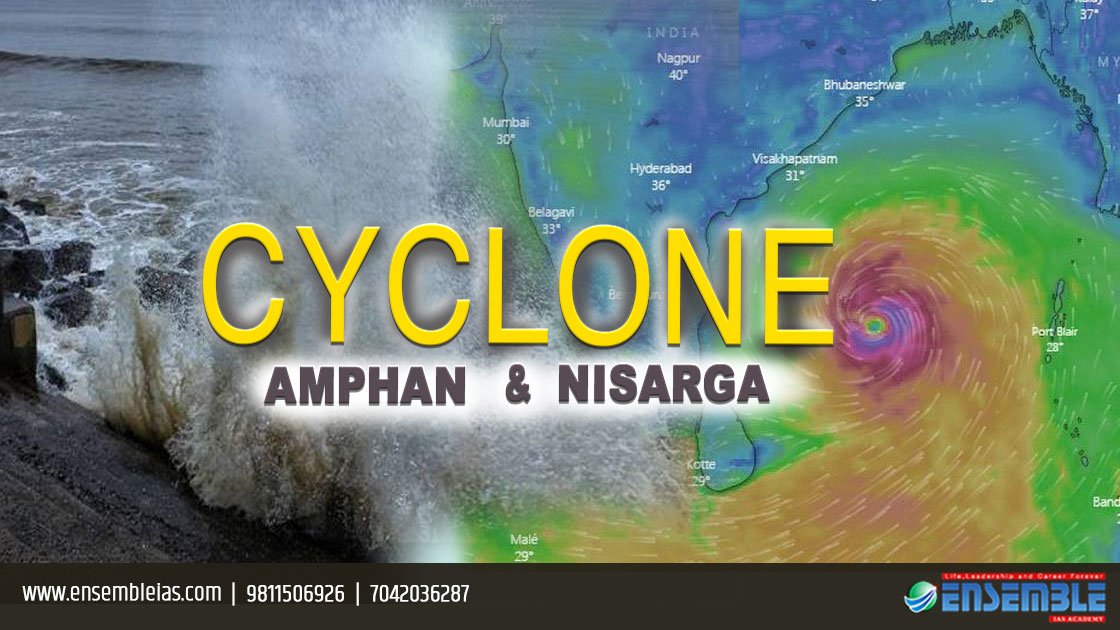Cyclone Amphan and Cyclone Nisarga: The North Indian Ocean tropical cyclone season is ongoing. Within a span of two weeks Indian coasts have already witnessed two cyclones – one on the Eastern Coast, that is in the Bay of Bengal and second on the Western Coast, in Arabian Sea.
What are Tropical Cyclones?
Tropical Cyclones are storms which originate as a result of low pressure systems, along with low-level air circulation. These cyclones invite strong winds and cause thunderstorms. Tropical cyclone is arranged in a spiral manner and is rotating in nature.
Several Conditions must be fulfilled for the formation of a tropical cyclone, some of them are-
- Source of sensible heat – which is moisture that provides the latent heat.
- Warm temperatures must be over a thick layer of about 60 -70m , so that cold water from below does not upwell and warm water supply is not cut off.
- Low level disturbances must be present which provide necessary winds.
- Disturbances in the upper-atmosphere.
Coriolis force – which is weak in 5° N and 5° S belt. Cyclone formation takes place beyond these latitudes due to strong coriolis force there.
 Cyclone Amphan was a deadly cyclone which developed in the Bay of Bengal and made landfall in India near Bakkhali in West Bengal on May 20. It is the strongest cyclone in Bay of Bengal since super cyclone of 1999. It striked the Ganges delta. Widespread damage was reported in West Bengal and Bangladesh.
Cyclone Amphan was a deadly cyclone which developed in the Bay of Bengal and made landfall in India near Bakkhali in West Bengal on May 20. It is the strongest cyclone in Bay of Bengal since super cyclone of 1999. It striked the Ganges delta. Widespread damage was reported in West Bengal and Bangladesh.
Sea surface temperatures were exceptionally high at about 32-34°C. Wind speeds as high as 240 km/hr were witnessed. It is also notable that since it striked the Ganges Delta, the storm surge could make its way to the hinterlands because of river mouth.
Upto 40% trees in Kolkata and several electricity poles were uprooted causing blocked roads and no electricity for not less than 3 days. Several migrant workers who returned home in West Bengal lost their homes in the severe cyclonic storms.

A different Cyclone Nisarga is an ongoing cyclone which has developed in the Arabian Sea. It made its landfall at Alibaug, Maharashtra. The wind speeds were recorded to be 100-110 km/hr.
The cyclonic storm after landfall is expected to reach till Nagpur. Mumbai has been hit by a cyclone after a gap of about 129 years.
Cyclone Nisarga has turned into a boon for rain shadow areas of Karnataka by providing rainfalls as a relief from scorching heat.
The formation of cyclones also cause delays to monsoons in India as the South-westerly winds get drawn towards the cyclone.
Why the frequency of cyclones is more in the Bay of Bengal than Arabian Sea?
A variety of factors explain this.
- Bay of Bengal has higher sea surface temperatures and humidity than the Arabian Sea, therefore the condition of warm water supply is more in Bay of Bengal.
- Numerous rivers drain into the Bay of Bengal, adding fresh and warm waters in the Bay of Bengal, as a result of this the vertical churning of water is low. A sluggish pattern of mixing of waters again provides conducive conditions for the maintenance of warm waters above.
- On the other hand, currents are strong on the Arabian Sea, which lead to rapid mixing of warm and cold waters.
- It also depends on the El Nino and La Nina conditions. During El Nino year, it is more likely to see cyclone formations in Arabian Sea because during El Nino the rising arm of walker circulation is located on Arabian Sea.
- During La Nina year, it is just the opposite. Rising arm is located over Bay of Bengal and sinking arm over the Arabian Sea.
- Due to less continuous landmass between the Bay of Bengal and the Pacific Ocean, Strong Pacific winds and also, remnants of typhoons aid the process of cyclone formation in the Bay of Bengal.
 Thus to conclude, cyclones are a natural phenomenon which take place every year. It is however, in human hands to prepare and be resilient towards it.
Thus to conclude, cyclones are a natural phenomenon which take place every year. It is however, in human hands to prepare and be resilient towards it.
Mangrove forests are nature’s way of reducing the effects of such cyclonic storms. It is important that a robust weather prediction mechanism is present in countries prone to such cyclone hits.
Evacuation of coastal population on time must be done. Warnings beforehand can save the lives of coastal residents.
AUTHOR:- Suramya Sharma
For more details : Ensemble IAS Academy Call Us : +91 98115 06926, +91 7042036287
Email: [email protected] Visit us:- https://ensembleias.com/
#cyclone #cyclone_amphan #cyclone_nisarga #geography #oceanography #enviroment #current_affairs #Indian_Goverment_System #bureaucracy #blog #geography_optional #upsc2020 #ias #k_siddharthasir #Government_of_India #india #studyabroad #geography #upsc #bhugol #government #news #dailynews #gk #dailyquiz #editorial
